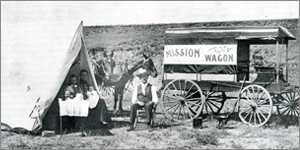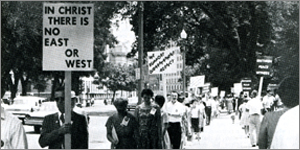


 |
| CLICK TO ENLARGE |
Few things distinguish one publication from another than the judicious arrangement of Photographs. Life magazine and National Geographic are famous for their photographic achievements. The “Cover of Time” magazine is a milestone credential for most people. A photograph can enlighten, interpret, answer, dismay, shock, encourage, inspire, and do it all without words. The Brethren Encyclopedia is enriched with copious samplings of notable Brethren personages, families, historical events, buildings, congregations, and social gatherings. All photographs are in black and white but pleasingly offer important cues about societal norms, church tradition, daily living, and satisfying our natural curiosity. Viewing a time lapse of photographs gives us a reasonable means of judging our progress, and making assumptions of our future. This media has allowed us to freeze history for an instant, and given us lasting perspectives about ourselves.
There is great educational value in photographs. It has been stated that 95% of all we learn comes through the human eyes. We have become a society that is driven by a continual need for pictures. Starvation became more real for many only after video and still pictures of dying Sudanese appeared on television and the front pages of national news magazines. It was then that enormous funds were raised to alleviate their plight. Death gained a national face when a fireman carried the charred body of a little child in his arms after the Oklahoma bombing. Pictures can emotionally interact with us. We fell those images tugging, and reaching deep down into our hearts to evoke compassion as the written word never could. We easily become a part of a distant or global event. They help us to tell a story. Your vacation is more dynamic when you have pictures to share with friends. We never seem to lose our fascination for photographs of a new-born infant. Even though we've seen these types of photos many times before, we still love to inspect tiny fingers and toes as though it was a first time event.
 |
| CLICK TO ENLARGE |
Photographs also help us to tell the Brethren story, and The Brethren Encyclopedia enriches us with over 500 photographs, drawings, and illustrations that provide us with the ability to put faces on our past and envision a reasonable framework of our future. The Brethren Church archives can be located at Ashland University. There are many different collections within each Brethren body. Archives within the Church of the Brethren include the Brethren Historical Library and Archives (BHLA), Messenger magazine, Annual Conference, numerous private collections that have been donated, and each of the six Brethren-related colleges, especially Elizabethtown and Juniata. The Brethren Encyclopedia offers many group photographs of congregations that would be of keen interest for genealogists who might also hold other family or individual photos, and wish to trace the geographical movements of families from church to church during a westward migration. The date of the photograph is usually included in the caption or accompanying text. Cultural studies would be enhanced by observing the styles of clothing in these group photographs. Historians might take cues from building construction. Some early Brethren meeting houses had two doors, as the Klein Meetinghouse. Men and women entered through their respective entrances and worshiped apart in separated areas. Other facilities had only one door. Meetinghouses of the 1800s were usually plain and unassuming. The turn of the Century witnessed a striking departure from previous norms to embrace a modern facade such as Nez Perce. But few issues caused more consternation than the pulpit area at the front of the meetinghouse. “Though Annual Meeting frequently ruled concerning the furnishings of meetinghouses, warning against bells, fancy carpeting, and baptismal pools, the issue receiving greatest attention at Annual meeting and in Brethren periodicals was the use of a Raised Pulpit or stand. By the 1870s a few congregations dared to introduce platforms or stands, arguing that a slightly raised platform made it easier to hear a preacher; and D. P. Sayler cited in its favor biblical examples of preaching from a stand. An article in ‘The Vindicator’ (1873) and a book by M. M. Eshelman (1874) warned Brethren against any architecture that would exalt or elevate a leader, and urged the use of a Reading Table on a level with the rest of the congregation as a mark of oneness, humility, equity, and brotherhood,” B.E. Vol. II, p. 1050..
 |
| CLICK TO ENLARGE |
Baptism was a central and solemn event in the life of a Brethren congregation.So central was baptism to the Brethren congregation that many churches were situated next to a stream and often bore the name of the nearby stream. The following are active churches: Bear Creek, Beaver Creek, Beaver Run, Blue River, Brummerts Creek, Bush Creek, Cedar Creek, Creekside, Donnels Creek, Eagle Creek, Eagle River, English River, Free Spring, Indian Creek, Linville Creek, Loon Creek, Lost Creek, Marsh Creek, Middle Creek, Mill Run, Nettle Creek, New Spring, Panther Creek, Peters Creek, Piney Creek, Pipe Creek, Red Creek, Rock Run, Sam's Creek, Sandy Creek, Shallow Falls, Silver Creek, Spring Creek, Spring Run, Stony Creek, Trout Run, Turkey Creek, and Upper Fall Creek to name a few. Brethren were founded and converted during the Anabaptist movement (rebaptizers) in Europe during the 1700s. In other words, they rebaptized adults who had been initially baptized as infants. Trine Immersion (Latin, trinus, threefold) was the accepted mode of immersion, and performed in the Name of the Father, the Son, and the Holy Spirit according to the instructions of Christ found in the gospel of Matthew 28:19. Spreading the Good News of Jesus Christ and the education of new converts was very important. The words Mission and Revival are frequently noticed in photographs of the Brethren Encyclopedia. Often the enterprise was a family affair. In the above photo, James Neff used a wagon to transport his entire family while preaching the gospel. The Brethren Church sponsored this Missionary Family to French Equatorial Africa. Evangelist J. Edwin Jarboe held revival meetings with prominently placed signs to welcome the non-believer. However, some Brethren groups strongly resisted this type of approach. Numerous questions were sent to Annual Meeting regarding the appropriateness of emotional appeals if not also accompanied by proper teaching on the importance of membership. By 1860 the progressive voices generally accepted this innovation but the conservative voices were generally opposed to protracted meeting with emotional appeals.
 |
| CLICK TO ENLARGE |
Brethren have remained one of the three historic peace churches, along with Mennonites and Quakers. The Brethren Encyclopedia contains a length article on the subject of peace, explaining this tradition to include a complexity of meanings: “These include the recognition that war is totally contrary to the teaching and example of Jesus Christ, a corporate refusal to go to war or train for it. a nonresistant readiness to suffer at the hands of others rather than to fight, advocacy of nonviolent ways for settling conflict rather than recourse to violence and war, a resolve to live in the way and spirit of Christ amid the world's confusion and strife,” B.E. Vol. II, p. 1050. The article continues to relate the history of peace during the early Roman Empire, the period of the emperor Constantine, the Middle Ages and the time of the Holy Wars or Crusades, the birth of the Schwarzenau Brethren in Germany, Brethren in America under the pacifist Quaker legislature, the Revolutionary war period, the first recorded statement of the Brethren peace position at the Annual Meeting of 1785, the Civil War period, conscientious objection, both World Wars, and the nuclear age. Scripture is richly included. Theology is briefly explained as in Matthew 18. Treatment is given to all aspects of militarism and the Christian response. Official statements from each of the Brethren bodies is included, one of which enjoins their members from the use of any military type of uniform, such as the Boy Scouts and Girl Scouts. Photographs depict the increased activism of the Brethren during the early 1960s. Photo at left shows the June 1962 Brethren peace march at the White House in the nation's capital.
Other Resources:
Annual Conference Statements and Resolutions (CB)
Brethren Digital Archives
Brethren Heritage Center -- Brookville, Ohio
Mennonite Heritage Center -- Harleysville, Pennsylvania
Valley Brethren-Mennonite Heritage Center -- Harrisonburg, Virginia
HOME : ABOUT BE : SAMPLE : PHOTOGRAPHS : HISTORY : ILLUSTRATIONS : OPPORTUNITY
Expressed written permission granted to Church of the Brethren Network by
Brethren Encyclopedia, Inc., 313 Fairview Avenue, Ambler, PA 19002
Graphic reproductions, Copyright, BEI 1983, COB-NET 2003
All rights reserved